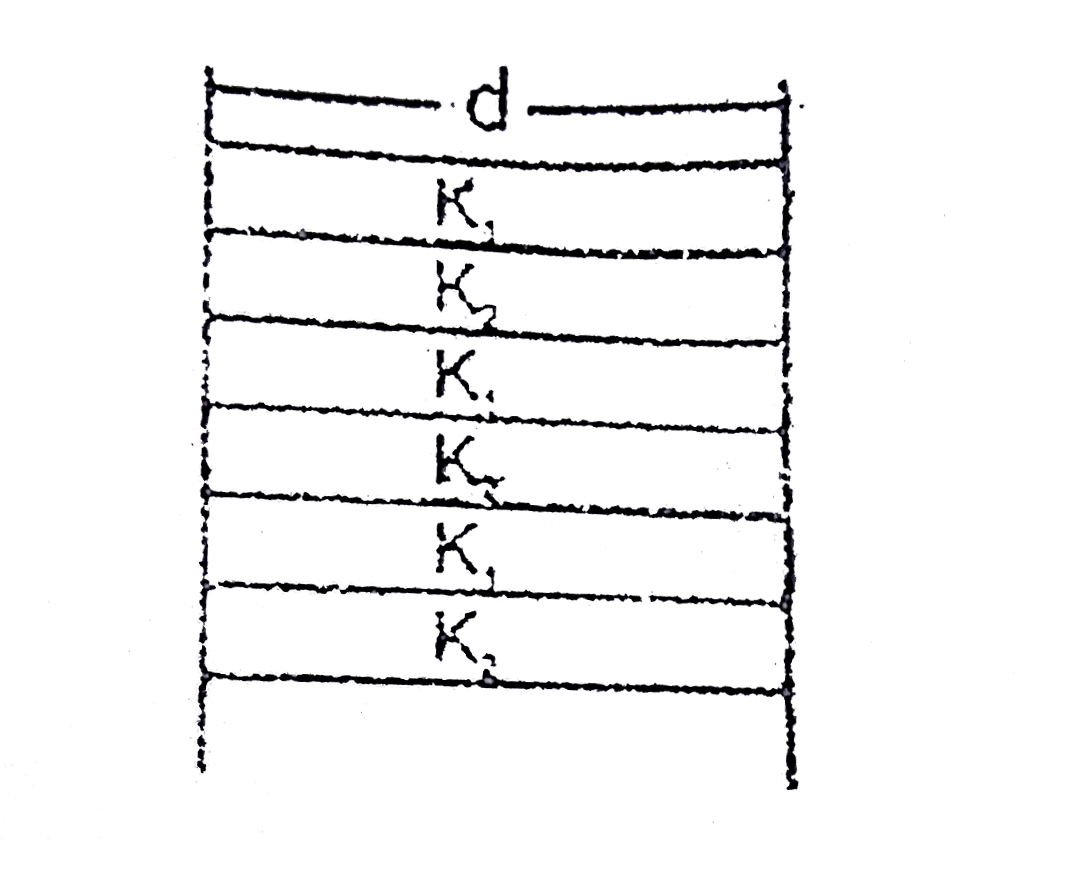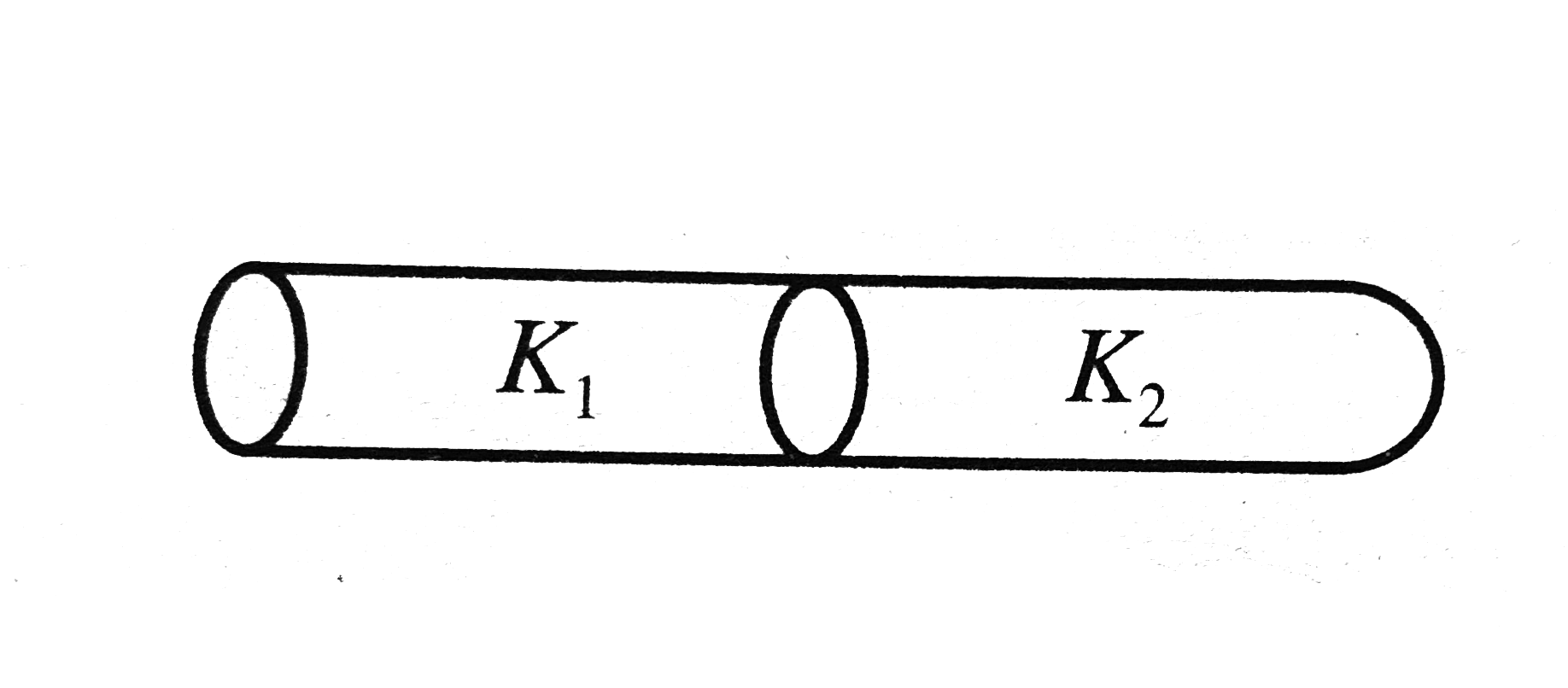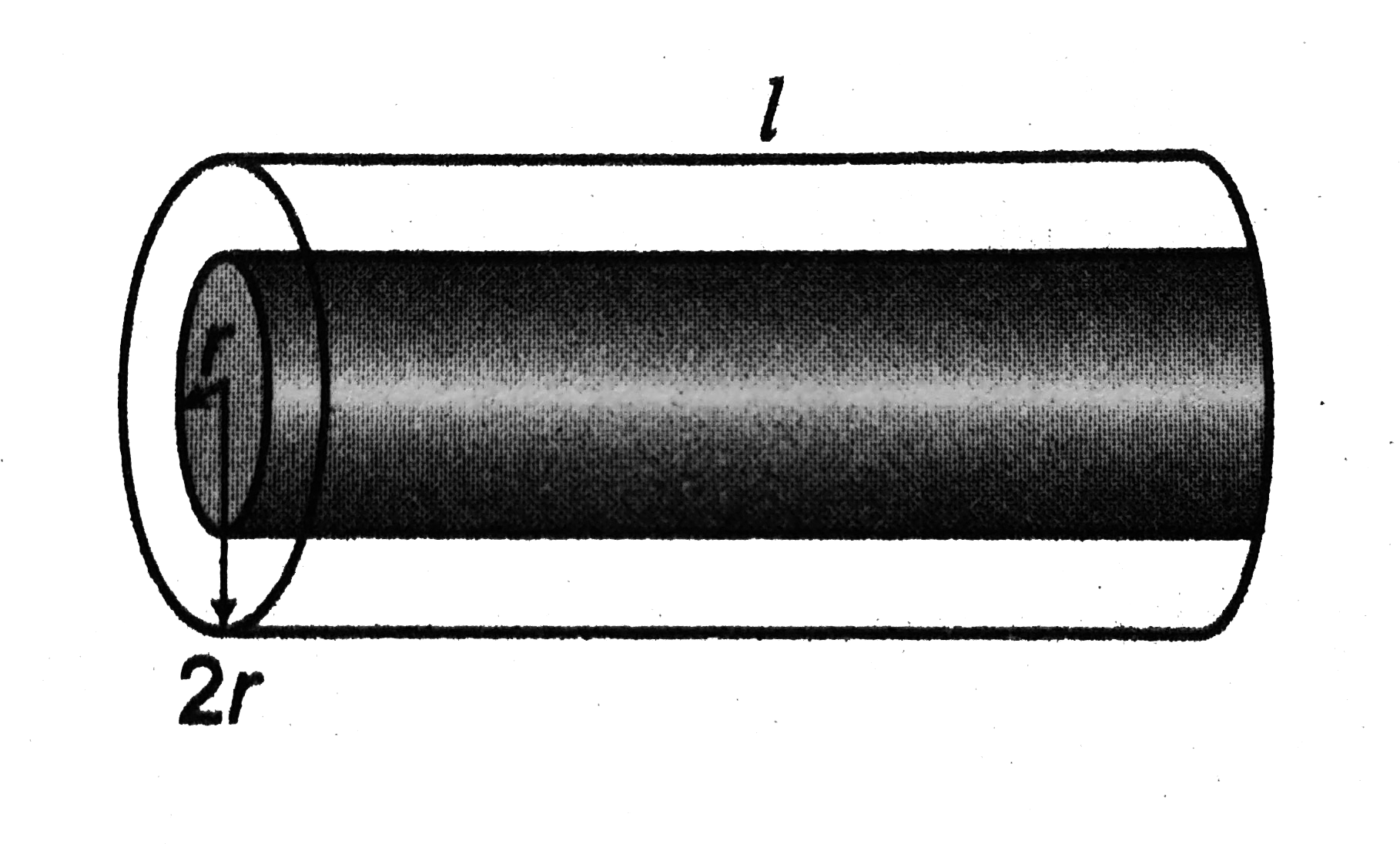Two rods of length l1andl2 and coefficients of thermal conductivities k1andK2 are kept touching each other. Both have the same area of cross-section. The equivalent of thermal conductivity is
K1+K2
K1l1+K2l2
K1l1+K2l2l1+l2
l1+l2(l1/K1)+(l2/K2)
The correct Answer is:D
To find the equivalent thermal conductivity of two rods that are in series, we can follow these steps:
1. Understand the Setup:
- We have two rods of lengths l1 and l2 with thermal conductivities k1 and k2, respectively.
- Both rods have the same cross-sectional area A and are in contact with each other.
2. Identify the Thermal Current:
- The thermal current I through each rod can be expressed using Fourier's law of heat conduction:
I=Qt=k1⋅A⋅(T1−T)l1(for rod 1)
I=Qt=k2⋅A⋅(T−T2)l2(for rod 2)
3. Set Up the Equations:
- Since both rods are in series, the thermal current I through both rods is the same:
k1⋅A⋅(T1−T)l1=k2⋅A⋅(T−T2)l2
4. Express Temperature Differences:
- Rearranging the equations gives:
T1−T=I⋅l1k1⋅A
T−T2=I⋅l2k2⋅A
5. Combine the Equations:
- Adding these two equations results in:
T1−T2=(I⋅l1k1⋅A+I⋅l2k2⋅A)
- Factor out I and A:
T1−T2=I⋅(l1k1⋅A+l2k2⋅A)
6. Express Equivalent Thermal Conductivity:
- The equivalent thermal conductivity keq can be defined as:
T1−T2=keq⋅A⋅(T1−T2)l1+l2
- Equating the two expressions for T1−T2:
l1+l2keq=l1k1+l2k2
7. Solve for keq:
- Rearranging gives:
keq=(l1+l2)(l1k1+l2k2)
Final Answer:
The equivalent thermal conductivity keq is given by:
keq=(l1+l2)(l1k1+l2k2)
- We have two rods of lengths l1 and l2 with thermal conductivities k1 and k2, respectively.
- Both rods have the same cross-sectional area A and are in contact with each other.
- The thermal current I through each rod can be expressed using Fourier's law of heat conduction:
I=Qt=k1⋅A⋅(T1−T)l1(for rod 1)
I=Qt=k2⋅A⋅(T−T2)l2(for rod 2)
- Since both rods are in series, the thermal current I through both rods is the same:
k1⋅A⋅(T1−T)l1=k2⋅A⋅(T−T2)l2
- Rearranging the equations gives:
T1−T=I⋅l1k1⋅A
T−T2=I⋅l2k2⋅A
- Adding these two equations results in:
T1−T2=(I⋅l1k1⋅A+I⋅l2k2⋅A)
- Factor out I and A:
T1−T2=I⋅(l1k1⋅A+l2k2⋅A)
- The equivalent thermal conductivity keq can be defined as:
T1−T2=keq⋅A⋅(T1−T2)l1+l2
- Equating the two expressions for T1−T2:
l1+l2keq=l1k1+l2k2
- Rearranging gives:
keq=(l1+l2)(l1k1+l2k2)
The equivalent thermal conductivity keq is given by:
keq=(l1+l2)(l1k1+l2k2)
Topper's Solved these Questions
- BOOK - ICSECHAPTER - COMPETITION CARE UNITEXERCISE - THERMAL RADIATION13videos
COMPETITION CARE UNIT
- BOOK - ICSECHAPTER - COMPETITION CARE UNITEXERCISE - OSCILLATIONS23videos
COMPETITION CARE UNIT
- BOOK - ICSECHAPTER - COMPETITION CARE UNITEXERCISE - INTERNAL ENERGY40videos
COMPETITION CARE UNIT
- BOOK - ICSECHAPTER - CIRCULAR MOTION EXERCISE - MODULE 2 (FROM ROTATIONAL KINETIC ENERGY , WORK ,POWER)24videos
CIRCULAR MOTION
- BOOK - ICSECHAPTER - DIMENSIONSEXERCISE - SELECTED PROBLEMS (FROM CONVERSIONS OF ONE SYSTEMS OF UNITS INTO ANOTHER)9videos
DIMENSIONS
Similar Questions
Two rods of length d1 and d2 and coefficients of thermal conductivites K1 and K2 are kept touching each other. Both have the same area of cross-section. The equivalent thermal conductivity.
View SolutionA wall consists of alternating blocks withlength 'd' and coefficient of thermal conductivity k1 and k2. The cross sectional area of the blocks are the same. The equivalent coefficient of thermal conductivity of the wall between left and right is:-
 View Solution
View Solution
Knowledge Check
- Question 1 - Select One
IF two metallic plates of equal thickness and thermal conductivities K1andK2 are put together face to face anda common plate is constructed, then the equivalent thermal conductivity of this plate will be
AK1K2K1+K2B2K1K2K1+K2C(K21_K22)3/2K1K2D(K21+K22)3/22K1K2
A composite slab is prepared by pasting two plates of thickness L1 and L2 and thermal conductivities K1 and K2 . The slab have equal cross-sectional area. Find the equivalent conductivity of the composite slab.
View Solution
Statement I: Two solid cylindrical rods of identical size and different thermal conductivity K1 and K2 are connected in series. Then the equivalent thermal conductivity of two rods system is less than that value of thermal conductivity of either rod.
Statement II: For two cylindrical rods of identical size and different thermal conductivity K1 and K2 connected in series, the equivalent thermal conductivity K is given by 2K=1K1+1K2View Solution
Statement I: Two solid cylindrical rods of identical size and different thermal conductivity K1 and K2 are connected in series. Then the equivalent thermal conductivity of two rods system is less than that value of thermal conductivity of either rod.
Statement II: For two cylindrical rods of identical size and different thermal conductivity K1 and K2 connected in series, the equivalent thermal conductivity K is given by 2K=1K1+1K2View SolutionTwo bodies of masses m1 and m2 and specific heat capacities S1 and S2 are connected by a rod of length l, cross-section area A, thermal conductivity K and negligible heat capacity. The whole system is thermally insulated. At time t=0 , the temperature of the first body is T1 and the temperature of the second body is T2(T2>T1) . Find the temperature difference between the two bodies at time t.
View SolutionTwo bodies of masses m1 and m2 and specific heat capacities S1 and S2 are connected by a rod of length l, cross-section area A, thermal conductivity K and negligible heat capacity. The whole system is thermally insulated. At time t=0 , the temperature of the first body is T1 and the temperature of the second body is T2(T2>T1) . Find the temperature difference between the two bodies at time t.
View SolutionThermal conductivity of inner core of radius r is K and of the outer one of radius 2r is 2K. Find equivalent value of thermal conductivity between its two ends.
 View Solution
View SolutionTwo identical plates with thermal conductivities K and 3K are joined together to form a single plate of double thickness. The equivalent thermal conductivity of one composite plate so formed for the flow of heat through its thickness is.
View Solution

